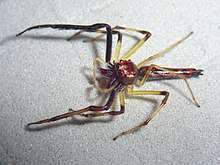Viciria
Viciria is a genus of jumping spiders that was first described by Tamerlan Thorell in 1877.[3] The genus includes thirty-one accepted species.[1]
| Viciria | |
|---|---|
 | |
| male V. praemandibularis | |
| Scientific classification | |
| Kingdom: | Animalia |
| Phylum: | Arthropoda |
| Subphylum: | Chelicerata |
| Class: | Arachnida |
| Order: | Araneae |
| Infraorder: | Araneomorphae |
| Family: | Salticidae |
| Genus: | Viciria Thorell, 1877[1] |
| Type species | |
| V. pavesii Thorell, 1877 | |
| Species | |
|
27, see text | |
| Synonyms[1] | |
Description
Both sexes reach a length of about 7 to 12 mm. Viciria is a colorful genus similar to Telamonia. However, the very long, thin opisthosoma of Viciria is almost cylindrical, and the color patterns differ. Viciria often shows a single broad longitudinal stripe with a pattern of black dashes on the opisthosoma. A white median stripe is present on the cephalus of the female.[4]
V. praemandibularis males have an orange carapace with bronze iridescent hairs on the cephalus, and an orange opisthosoma with a dark brown median stripe. The legs are yellowish, except for the brown first pair. The carapace of the female is yellowish with a white stripe, bordered by two orange stripes. The median stripe of the opisthosoma is bright orange, narrowly bordered with white. The rest of the opisthosoma is yellowish. The legs are paler than in males.[4]
Species
- Viciria alba Peckham & Peckham, 1903 — Southern Africa
- Viciria albocincta Thorell, 1899 — Cameroon, Gabon
- Viciria albolimbata Simon, 1885 — Sumatra
- Viciria arrogans Peckham & Peckham, 1907 — Borneo
- Viciria chabanaudi Fage, 1923 — West Africa
- Viciria chrysophaea Simon, 1903 — Gabon
- Viciria concolor Peckham & Peckham, 1907 — Borneo
- Viciria detrita Strand, 1922 — Sumatra
- Viciria diademata Simon, 1902 — India
- Viciria diatreta Simon, 1902 — India
- Viciria epileuca Simon, 1903 — Gabon
- Viciria equestris Simon, 1903 — Gabon
- Viciria equestris pallida Berland & Millot, 1941 — Ivory Coast
- Viciria flavipes Peckham & Peckham, 1903 — South Africa
- Viciria flavolimbata Simon, 1910 — Guinea-Bissau
- Viciria lucida Peckham & Peckham, 1907 — Borneo
- Viciria minima Reimoser, 1934 — India
- Viciria miranda Peckham & Peckham, 1907 — Borneo
- Viciria moesta Peckham & Peckham, 1907 — Borneo
- Viciria monodi Berland & Millot, 1941 — Ivory Coast
- Viciria pallens Thorell, 1877 — Sulawesi
- Viciria paludosa Peckham & Peckham, 1907 — Borneo
- Viciria pavesii Thorell, 1877 — Sulawesi
- Viciria petulans Peckham & Peckham, 1907 — Borneo
- Viciria polysticta Simon, 1902 — Sri Lanka
- Viciria praemandibularis (Hasselt, 1893) — Singapore to Sulawesi
- Viciria prenanti Berland & Millot, 1941 — Ivory Coast
- Viciria rhinoceros Hasselt, 1894 — Sulawesi
- Viciria scintillans Simon, 1910 — West Africa
- Viciria semicoccinea Simon, 1902 — Java
- Viciria tergina Simon, 1903 — Equatorial Guinea
Transitions
Following species were transferred to other genera.
- Viciria besanconi - to Telamonia
- Viciria fuscimana - to Telamonia
- Viciria longiuscula - to Telamonia
- Viciria mondoni - to Brancus
- Viciria niveimana - to Brancus
- Viciria ocellata - to Thyene
- Viciria peckhamorum - to Brancus
- Viciria thoracica - to Telamonia
References
- "Gen. Viciria Thorell, 1877". World Spider Catalog. Retrieved 4 June 2016.
- Prószyński, J. (1984). "Remarks on Viciria and Telamonia (Araneae, Salticidae)". Annales Zoologici, Warszawa. 37: 420.
- Thorell, T. (1877). "Studi sui Ragni Malesi e Papuani. I. Ragni di Selebes raccolti nel 1874 dal Dott. O. Beccari". Annali del Museo Civico di Storia Naturale di Genova. 10: 341–637.
- Murphy & Murphy 2000: 301
- Murphy, Frances & Murphy, John (2000): An Introduction to the Spiders of South East Asia. Malaysian Nature Society, Kuala Lumpur.
- Platnick, Norman I. (2009): The world spider catalog, version 9.5. American Museum of Natural History.
External links
| Wikimedia Commons has media related to Viciria praemandibularis. |
- Salticidae.org: Photograph of Viciria sp.
- Photograph of V. praemandibularis with eggs